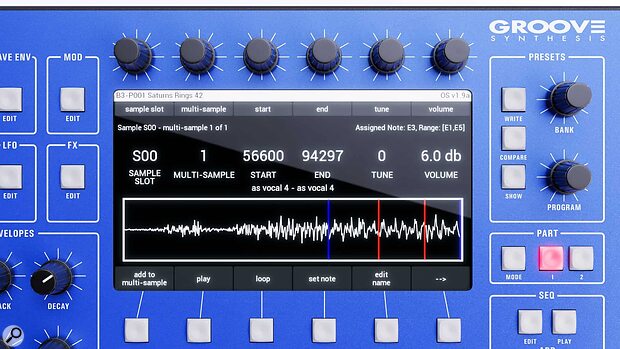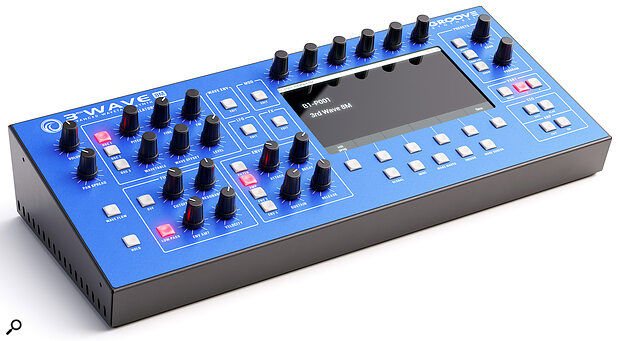The third wave of the 3rd Wave reduces both size and price, but retains the sound that made us love it in the first place.
When Groove Synthesis first unveiled the original 3rd Wave keyboard in 2022, it landed like a well‑executed surf trick. Drawing from the lineage of the PPG Wave, but updated with numerous modern enhancements, it features three wavetable oscillators per voice, analogue filters and a comprehensive modulation engine. The keyboard version was a tour de force: 24 voices, a five‑octave keybed with aftertouch, and no corners cut in build quality — but it had a price tag to match. Its follow‑up, the 3rd Wave Desktop, maintained the voice count but dropped the keybed and some physical controls. Still, the price remained out of reach for many.
The 3rd Wave 8M is the third member of the family — and the most accessible. The price finally dips below £2000$2000, but not without a few sacrifices. In this review, we’ll examine what has been retained, what has been removed, and whether the 8M will appeal to readers who value their wallet as much as their desk space.
The Big Picture
The 8M is an eight‑voice, two‑part multitimbral, desktop module version of the 3rd Wave. The most obvious departure from its predecessors is the voice count: the original keyboard version boasted a generous 24 voices, and the Desktop offered the same. This time, we’re working with just eight voices. That’s a considerable reduction. In practice, eight voices — each with three oscillators, analogue filters, four envelopes, four LFOs and an extensive mod matrix — can still deliver a sonic wallop. But you might encounter voice‑stealing when playing big chords on sounds with a long release.
Crucially, the sound engine has not been nerfed. You still get all three oscillators per voice, each capable of virtual analogue waveforms, linear FM, wavetables (with 92 factory wavetables and support for user wavetables in Serum format) or sample playback. You also retain the multi‑mode analogue filter section, featuring an SSI 2140 low‑pass filter and a second digital state‑variable filter.
In essence, what Groove Synthesis have delivered is a smaller box, fewer voices, and fewer physical controls — but with no compromise to sound quality or core synth features. At £1779$1999, it opens the door to anyone who baulked at the Desktop’s £3499$3499 price tag or the Keyboard’s hefty £4999$4999 commitment.
Front Panel Philosophy
Physically, the 8M is compact yet solidly built. Measuring 53 x 29 x 20cm, it should fit comfortably on any desktop. It’s also the only 3rd Wave that is rackmountable, and it comes with ears included.
The front‑panel layout is clean, logical and clearly descended from the Desktop version, albeit trimmed further. There are still dedicated knobs and buttons for key global, oscillator, filter and envelope functions, but many parameters are now consigned to the LCD screen. To this end, Groove Synthesis have equipped the 8M with a much larger seven‑inch screen and increased the number of soft knobs to six, which makes the 8M feel different from its older siblings. Both the Keyboard and Desktop versions managed to make the screen feel like a small but necessary part of a much bigger system. You could edit sounds with only the occasional need to peer into the digital window. The 8M’s screen size, especially in relation to the smaller physical front panel, makes it feel like the primary focus of the synth, which is not something I felt with the other two models.
 Groove Synthesis 8M desktop synth showing its LCD screen.
Groove Synthesis 8M desktop synth showing its LCD screen.
Oscillators & Wavetable Power
Let’s recap the 3rd Wave’s synthesis capabilities. Aside from the reduction in voices and a shift from four‑part to two‑part multitimbrality, everything about the synthesis engine remains the same as the keyboard and desktop versions. I’ll summarise here, but for a more in‑depth description, I refer you to the previous Keyboard review (SOS March 2023) and Desktop review (SOS October 2024).
The 3rd Wave is primarily a wavetable synthesizer built on the shoulders of the PPG Wave. The combination of digital wavetables with analogue low‑pass filters is the main attraction. The 36 original 8‑bit PPG wavetables are complemented by 56 modern 96kHz variants and 20 empty slots for your own, although the factory wavetables can be overwritten if you’re feeling adventurous. A built‑in wavetable creator helps you generate new wavetables from imported or recorded audio.
One of the more recent additions to the 3rd Wave engine is sampling. Oscillators can now play back multisamples, with up to eight samples spread across the keyboard. Only 3.3MB of RAM is available, which allows for approximately 35 seconds at 48kHz (or more if you use lower sample rates). Only mono samples are supported. In my review of the 3rd Wave Desktop, I concluded that sampling would not be the reason you bought the 3rd Wave, but it’s a nice bonus to have, and I stand by that.
In addition to the filters already mentioned, there is oscillator sync, linear FM, four envelopes, four LFOs, an arpeggiator, a sequencer, and two effects slots featuring three types of delay (BBD, Tape and Stereo), three reverbs (Room, Hall and Superplate), chorus, phaser, flanger, ring modulator, Leslie speaker and distortion. All of this is per‑part, so each has dedicated effects, modulation and sequencing.
Modulation is another strong point. The mod matrix offers 16 user slots and 12 fixed slots. Sources include envelopes, LFOs, velocity, key position, poly and mono aftertouch, random generators and more. Destinations are virtually everything. Mod assignments can be made via the matrix or directly from parameter pages.
The four envelopes are of the DADSR variety, and there are also three six‑stage loopable envelopes (one per oscillator) primarily designed to sweep through wavetables. You can’t say the 3rd Wave doesn’t give you enough envelopes for your money! The LFOs are tempo‑sync’able and fully assignable. Again, all this modulation depth is identical to the larger models.
Sequencing, Performance & Multitimbrality
The sequencer is another highlight: each Part gets up to 24 patterns and 32 measures. You can record both notes and automation into a sequence, and patterns can be chained together to create songs. Sequences are saved with patches, can sync to clock, and can be used either for traditional pattern‑based work or as modulation recorders.
Multitimbral support means the 8M can handle two distinct patches from separate MIDI channels or keyboard zones. With only eight voices to share, multitimbral use does require more voice budgeting than with the 24‑voice models — but it’s still very usable, especially with less poly‑hungry sounds. Just don’t try recreating an entire Depeche Mode album in one patch — unless you’re into avant‑garde silence.
Its eight voices can be split between two Parts, each with a dedicated stereo output on the rear, allowing you to process them separately. Parts can be stacked or keyboard split.
What’s Missing?
So what do you lose compared to the full‑fat 3rd Wave?
- Voice count: eight vs 24 is a significant drop, especially for multitimbral, layered or ambient work.
- Keybed and live playability: You’ll need a MIDI controller — ideally with MPE or poly aftertouch.
- Physical controls: The interface is more screen‑reliant. While nothing is hidden too deeply, you’ll spend a lot more time looking at the screen.
- Multitimbral flexibility: You get two multitimbral Parts instead of four, but fewer voices to spread between them. It’s nice that you still get a dedicated stereo output for each Part.
What you don’t lose, crucially, is the sonic capability. The complete wavetable engine, virtual analogue engine (which sounds great by itself), FM synthesis, sampling, filters, modulation matrix, arpeggiator, sequencer and effects are all retained. Any patch made for the flagship can be loaded onto the 8M, and vice versa. However, any flagship patches that utilise Parts 3 and 4 will have those parts removed.
Conclusion
The Groove Synthesis 3rd Wave 8M is an effort to reach a broader audience, most likely those who cannot or will not spend £3500$3500 or more. While the price remains high, at £1779$1999, this is likely as affordable as the 3rd Wave will be. The drop from 24 to eight voices might feel a little severe (12 might have felt less hatchety and would have preserved the six‑voice‑per‑part symmetry of the larger models). And the hands‑on feel, which the Desktop version managed to preserve so well, is compromised by fewer physical controls and the much larger screen. Plus, if you’re not firmly committed to the PPG‑style sound, there are certainly cheaper wavetable options on the market.
The sound is still gorgeous. Silky textures, cinematic polysynths, layered sequences, crystal‑clear FM pianos and gutsy basses all sound as magnificent as the full £5000$5000 keyboard version.
However, there are still many things to like about the 8M. Most importantly, the sound is still gorgeous. Silky textures, cinematic polysynths, layered sequences, crystal‑clear FM pianos and gutsy basses all sound as magnificent as the full £5000$5000 keyboard version. And those PPG sounds are still 100 percent achievable (and let’s not forget that the PPG Wave 2.3 was also only eight‑voices, and that didn’t stop it from becoming a legend). Then there is the build quality — still excellent, with a metal chassis and wobble‑free encoders.
Ultimately, it comes down to how comfortable you are with reductionism. Groove Synthesis should be commended for preserving the sound quality, synth engine and ruggedness (including full‑size MIDI ports and quarter‑inch audio jacks on the rear). Whether the remaining compromises are acceptable is a personal call.
Is it as immediate and jaw‑dropping as the Keyboard version? No. Does it feel as luxurious? No. But the 3rd Wave 8M doesn’t aspire to opulence — it aims to make world‑class wavetable synthesis more available, portable and affordable. On those counts, it’s a success. The 3rd Wave 8M might be the wave that actually carries you to shore.
Round The Back
A 15V, 2A DC adaptor is included to supply power. The USB Type‑B port supports USB MIDI and flash memory access for wavetable/sample transfer, OS updates and patch backups. MIDI in, out and thru is supplied by 5‑pin DIN connectors. And just like the bigger models, you also get quarter‑inch jacks for sustain and expression pedals, mono audio input (for wavetable/sample recording), two pairs of stereo outputs (one per multitimbral Part), and a headphone socket.
Pros
- Equipped with the same powerful engine as the flagship models.
- Beautiful wavetable synthesis with sampling support.
- Bi‑timbral with separate outputs per Part.
- Rackmountable.
- More affordable...
Cons
- ...but still expensive compared to similar products.
- Reduced from 24 voices to eight voices.
- Reduced physical controls mean a greater reliance on the screen.
Summary
The 3rd Wave 8M is the latest repackaging of Groove Synthesis’ flagship wavetable engine. It’s the smallest and most affordable version, reducing the voice count from 24 to eight — but retaining all the core features and, crucially, that lovely sound.


